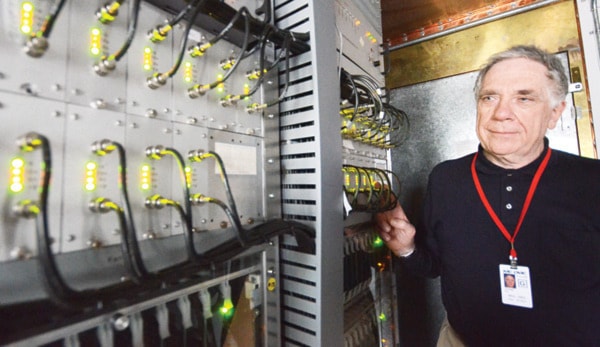One of the great experiences we can have in this country is to get out into the wilderness, a long way from people, and experience what a dark, clear night sky can be like.
In my opinion the very best way to enjoy the experience is lying on the bottom of a canoe in the middle of a lake. An intriguing thought when out there thinking of stars and space is that we are not really seeing out that far at all. Apart from the glow of the Milky Way, pretty well everything we can see lies within a few thousand light years. With the exception of that faint glowing blob we see in the autumn skies, which is the nucleus of the Andromeda Galaxy, some 2.5 million light years away, we are scarcely seeing beyond our cosmic front porch step, let alone out of our cosmic back yard. Of course all those very distant galaxies are out there too; it is just that they are too faint to see. That is astronomyís main challenge; most cosmic objects are very faint, especially the very distant ones.
To make faint objects visible we need to collect more light. A pair of binoculars with objective lenses 50mm in diameter will collect about a hundred times as much light as can our unaided eyes. However, almost all current astronomical research requires much larger light collectors than that. This brings us into a realm of engineering involving two factors that rarely turn up together: size and precision. We might make buildings and bridges accurately, but we make watches precisely. Now however we need to be able to make huge things very precisely. A good example is the Large Hadron Collider, a research facility near Geneva. Then of course there are the large optical telescopes needed for modern astronomy.
The objective lens or mirror of a telescope fulfils two functions: it collects the light from distant objects and uses that light to form an image. The more light that is collected the brighter the image. To be a light collector and imager of any use, the errors in the shape of the surface of the objective should not exceed about a tenth of the wavelength of the light being collected. That means that to be of any use for optical imaging, a telescope objective cannot have surface errors bigger than about 40 billionths of a metre. No watch has ever been manufactured to such tolerances. However, weíve achieved this with mirrors eight metres in diameter and are planning a telescope with a 30 metre mirror.
There are two challenges: making a mirror to that accuracy and then keeping it that way as it tilts at different angles. The Hale Telescope, completed in 1948, has a 200 inch (5.2 m) mirror. To be stiff enough to stay in shape, the mirror was made using 20 tonnes of special borosilicate glass. Learning how to cast and then cool the mirror without it cracking was a challenge. However, this approach will not work for making larger mirrors. They will be far too heavy and would sag out shape just under their own weight. The other problem is that small differences in temperature across the mirror will make it go out of shape, and the larger the mirror, the harder it is to achieve a uniform temperature. This has made the design of telescope domes and their ventilation systems an advanced technology in its own right.
The modern approach to telescope design is to make the mirrors thin, in one piece or in the form of tiles. There are computer-controlled adjustment points on the back of the mirror which allows the thin surface to move or flex, taking out the bending as the telescope moves and the effects of temperature changes. The result is that we can now see deeper into space than ever before, and the thirty metre telescope will push back the frontiers of visibility even further, which is something to dream about while lying on the bottom of that canoe, looking at the stars.
Mars is low in the south after sunset. Saturn and Venus are very low in the sunset glow. The Moon will be New on Nov.30.
Ken Tapping is an astronomer with the National Research Council's Dominion Radio Astrophysical Observatory, Penticton, BC.
